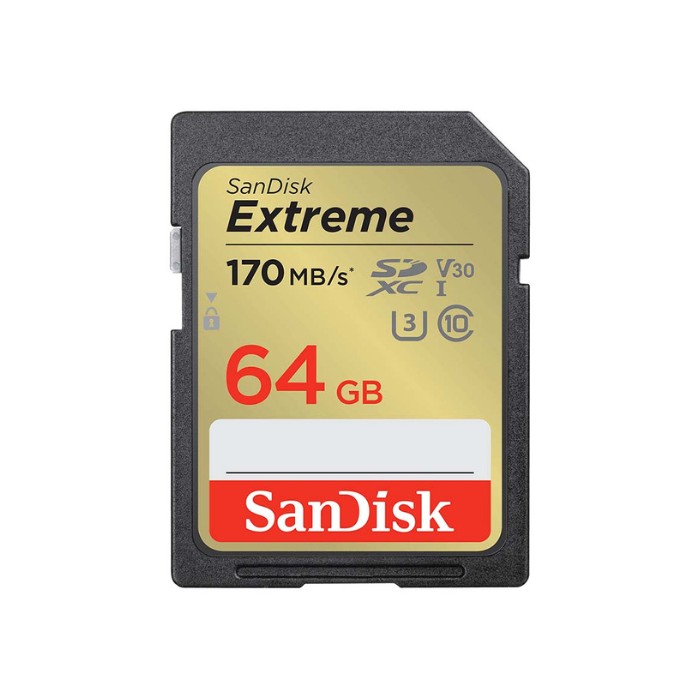Having a high-quality camera alone doesn’t guarantee that you can make the most out of its capabilities. The camera’s true potential also depends on the speed and performance of the memory card it uses. SanDisk is a well-known brand when it comes to memory cards, known for their reliability and quality. Among their offerings, the SanDisk Ultra and Extreme series have become popular choices among both photographers and videographers. In this article, we will compare the SanDisk Ultra vs Extreme memory cards, helping you decide which one is better suited for your needs.
SanDisk Ultra Overview
The SanDisk Ultra memory card, introduced in 2020, is specifically tailored for low-end and entry-level cameras. Its popularity stems from its appeal to beginner photographers and videographers. Like other SanDisk memory cards, the Ultra series can read and write photo and video files.
The SanDisk Ultra memory card is widely recognized and popular because it offers a great combination of affordability. When beginner photographers and videographers begin their creative journeys, they want a memory card that is not only affordable but also delivers good quality. The SanDisk Ultra fits the bill perfectly by providing a balance between price and performance. It’s a great choice for those who are new to photography and videography and want a reliable memory card without paying a big price.

SanDisk Extreme Overview
The SanDisk Extreme memory card is specifically designed for high-end and professional mirrorless and DSLR cameras that excel in capturing high-resolution photos and videos. It serves as a reliable choice for photographers and videographers who demand enhanced performance and storage capabilities. When comparing the SanDisk Extreme to its counterparts, it falls somewhere in the middle in terms of performance. While it surpasses the SanDisk Ultra in terms of speed and efficiency, it doesn’t quite match the lightning-fast performance of the SanDisk Extreme Pro.

Comparation SanDisk Ultra vs Extreme
Let’s find out every core factor that makes differences between SanDisk Ultra vs Extreme:
Similarities
Although the SanDisk Extreme and Ultra memory cards have different speeds, they share several common features due to their shared origin from SanDisk:
- Robust Durability: Both memory cards are built to withstand tough conditions. They can endure shocks up to 500 Gs and operate within a wide temperature range of -13 to 185 degrees Fahrenheit without sustaining damage.
- Storage Formats: The SanDisk Extreme and Ultra cards utilize similar storage formats. FAT16 is used for SD cards, FAT32 for SD High Capacity (SDHC) cards, and exFAT for SD Extended Capacity (SDXC) cards. This compatibility ensures easy file management across different devices.
- Resilience to External Factors: Both cards are designed to withstand exposure to magnetic fields and X-rays without any adverse effects on their performance or data integrity.
- UHS-I Technology: The SanDisk Extreme and Ultra models employ a single row of pins, making them UHS-I cards. This technology enables a maximum transfer speed of approximately 104MB/s, allowing for efficient data transfer between the memory card and the camera.
Differences
The main differentiating factor between the SanDisk Ultra vs Extreme memory cards is their speed:
Read speeds

We conducted tests using HDD Tune Pro. On the left, we have the SanDisk Ultra, with a read speed of up to 48MB/s. Meanwhile, the SanDisk Extreme achieved a read speed of 47MB/s. This indicates that the read speeds of the Ultra and Extreme are quite similar. High read speeds facilitate faster file viewing, but they do not directly impact the process of capturing photos and videos. What we need to consider is the write speed.
Write speeds

We utilized the CrystalDiskMark software to measure the write speeds of the three memory card types. The test involved writing a large 4GB file continuously to gauge the performance differences. Upon reviewing the test results, the SanDisk Ultra exhibited remarkable performance beyond expectations. While SanDisk claims a stable write speed of 10MB/s for the Ultra variant, it achieved a maximum write speed of up to 34MB/s. This speed is sufficient for recording Full HD videos and capturing RAW photos, although it may not be fast enough for continuous RAW shooting. On the other hand, the SanDisk Extreme boasted even higher speeds, reaching up to 43MB/s
Available Storage Capacity Options
When choosing a memory card for your camera, it’s essential to consider the available storage capacity options. After all, the purpose of a memory card is to provide ample storage for your recorded videos and photos. In terms of storage capacity, the SanDisk Ultra offers a wider range of options compared to the SanDisk Extreme. Here are the available storage capacity options for each model.
SanDisk Ultra:
- Micro SD cards with an SD adapter: Available in capacities ranging from 16GB up to 1TB.
- Standard SD cards (SDXC/SDHC): Available in capacities ranging from 64GB up to 256GB.
- Standard SD cards (SDXC UHS-I and SDHC UHS-I): Available in capacities ranging from 16GB up to 512GB.
SanDisk Extreme:
- Micro SD cards: Available in capacities ranging from 16GB up to 256GB.
- Standard SD cards: Available in capacities ranging from 32GB up to 256GB.
- Compact Flash cards: Available in storage options of 32GB, 64GB, and 128GB.
In the comparison SanDisk Ultra vs Extreme. The diverse capacity options of Sandisk Ultra ensure that you can select the one that best suits your needs, allowing you to capture and store a significant amount of content without worrying about running out of space on your memory card.
Video speeds
The key distinguishing factor between the SanDisk Ultra and SanDisk Extreme memory cards lies in their video speed class. The video speed class indicates the card’s ability to write video data and is denoted by a V followed by a number representing the actual speed.
Memory cards without a V label utilize the default video class speed. In contrast, the SanDisk Extreme carries a V30 label, indicating a video speed class capable of recording videos at 30MB/s. This high speed makes it suitable for capturing higher-resolution videos, including 4K, using advanced mirrorless and DSLR cameras.
Conversely, the SanDisk Ultra lacks a V label and operates at the default video class speed of 10MB/s. As a result, the Ultra model is limited to recording videos up to the full HD resolution of 1080 pixels and cannot handle higher-resolution video recording.

When to Use SanDisk Ultra
When deciding between the SanDisk Ultra and SanDisk Extreme memory cards, consider the following points that make the Ultra model a good choice:
- Compatibility: The Ultra model works with a wide range of devices, making it suitable if you plan to use the memory card across different devices.
- Budget-Friendly: The Ultra model is more affordable than the Extreme, making it a better option for beginner photographers on a tight budget.
- Large Storage Capacity: With a maximum storage capacity of 1TB, the Ultra model is ideal for recording long videos without worrying about running out of space.
Considering these factors, the SanDisk Ultra is a versatile and cost-effective option, especially if you need compatibility, affordability, and ample storage for recording extended videos.
When to Use SanDisk Extreme
The SanDisk Extreme memory card is the optimal choice for the following situations, thanks to its advanced features and superior read and write speeds:
- Continuous Burst Mode Photography: When capturing raw images in burst mode, the Extreme model provides storage with a shorter buffer time, allowing for faster consecutive shots without slowdown.
- High-Resolution Video Recording: If you intend to record videos with resolutions higher than 1080 pixels, the Extreme memory card is the ideal option. Its faster read and write speeds ensure smooth and uninterrupted video recording, even at higher resolutions such as 2K or 4K.
Conclusion
In the comparison between the SanDisk Ultra vs Extreme memory cards, both options offer reliable storage solutions for different photography and videography needs. The SanDisk Ultra is popular among beginners and budget-conscious users, providing a balance between affordability and performance. On the other hand, the SanDisk Extreme caters to professionals and enthusiasts who require faster read and write speeds, especially for continuous burst mode photography and high-resolution video recording.
Ultimately, the choice between the SanDisk Ultra vs Extreme depends on your specific requirements, budget, and the capabilities of your camera. Consider factors such as storage capacity, speed, compatibility, and intended use to determine which memory card suits your needs best. Whether you opt for the Ultra or Extreme, both offer the reliability and quality associated with the trusted SanDisk brand.
Contact Kolorheaven immediately via the Hotline at +84.899.779.111 or email: kolorheaven@cskolorheaven.com if you want to use our services.
Contact Info:
- Address: 22 TT1 – Tu Hiep auction site, Thanh Tri, Hanoi
- Website: https://kolorheaven.com/
- Email: kolorheaven@cskolorheaven.com
- Fanpage: https://www.facebook.com/Kolorheaven.services







